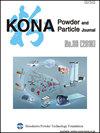DEM Modelling of Segregation in Granular Materials: A Review
IF 3.2
4区 材料科学
Q3 ENGINEERING, CHEMICAL
引用次数: 0
Abstract
Segregation control is a challenging yet crucial aspect of bulk material handling processes. The discrete element method (DEM) can offer useful insights into segregation phenomena, provided that reliable models are developed. The main challenge in this regard is finding a good balance between including particle-level details and managing the computational load. This is especially true for industrial applications, where multi-component flows consisting of particles with various irregular shapes and wide size distributions are encountered in huge amounts. In this work, we review the state of the art in DEM modelling of segregation in industrial applications involving the gravity-driven flow of dry, cohesionless granular materials. We start by introducing a novel scientific notation to distinguish between different types of mixtures. Next, we review how parameters for mixture models are determined in the current literature, and how segregation is affected by material, geometric and operational parameters based on these models. Finally, we review existing segregation indices and their applicability to multi-component segregation. We conclude that systematic calibration procedures for segregation models are currently missing in the literature, and realistic models representing multi-component mixtures have not yet been developed. Filling these gaps will pave the way for optimising industrial processes dealing with segregation.颗粒材料中偏析的DEM建模:综述
分离控制是散装物料处理过程中一个具有挑战性但又至关重要的方面。如果建立了可靠的模型,离散元法(DEM)可以对分离现象提供有用的见解。这方面的主要挑战是在包括粒子级细节和管理计算负载之间找到一个很好的平衡。在工业应用中尤其如此,在工业应用中,由各种不规则形状和宽尺寸分布的颗粒组成的多组分流会大量遇到。在这项工作中,我们回顾了工业应用中涉及重力驱动的干燥无黏结颗粒材料流动的分离的DEM建模的最新进展。我们首先引入一种新的科学符号来区分不同类型的混合物。接下来,我们回顾了当前文献中如何确定混合模型的参数,以及基于这些模型的材料、几何和操作参数如何影响偏析。最后,回顾了现有的偏析指标及其在多组分偏析中的适用性。我们得出的结论是,目前文献中缺乏对偏析模型的系统校准程序,并且尚未开发出代表多组分混合物的现实模型。填补这些空白将为优化处理隔离的工业过程铺平道路。
本文章由计算机程序翻译,如有差异,请以英文原文为准。
求助全文
约1分钟内获得全文
求助全文
来源期刊

KONA Powder and Particle Journal
工程技术-材料科学:综合
CiteScore
8.40
自引率
4.90%
发文量
35
审稿时长
>12 weeks
期刊介绍:
KONA publishes papers in the broad field of powder science and technology, ranging from fundamental principles to practical applications. Papers describing technological experience and critical reviews of existing knowledge in special areas are also welcome.
 求助内容:
求助内容: 应助结果提醒方式:
应助结果提醒方式:


